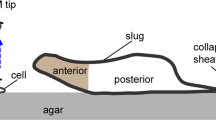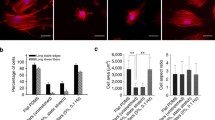Abstract
TROPISTIC and tactic responses to stresses in an elastic substrate have been described for several kinds of biological material. The true bacterium Kurthia zopfii, when grown in gelatin subjected to mechanical tension, reflects precisely in its pattern of growth the pattern of stresses in the substrate1–3 ; a similar response is shown by nerve fibres cultivated on stretched coagulated plasma4. Jacobsen1 proposed the name 'elasticotropism' for this type of behaviour. A few years ago, the corresponding tactic response was demonstrated in myxobacteria on stretched agar gels5. The effect of elasticotaxis in these organisms is particularly striking through its secondary influence on the fruiting process ; the rigidly oriented movement of the vegetative cells causes marked abnormalities in the shape and distributional pattern of the fruiting bodies.
Similar content being viewed by others
References
Jacobsen, H. C., Centr. Bakt., ii, 17, 53 (1907).
Sergent, E., Ann. Inst. Pasteur, 20, 1005 (1906).
Sergent, E., Ann. Inst. Pasteur, 21, 842 (1907).
Weiss, P., J. Exp. Zool., 68, 393 (1934).
Stanier, R. Y., J. Bact., 44, 405 (1942).
Author information
Authors and Affiliations
Rights and permissions
About this article
Cite this article
STANIER, R. Oriented Movement of Blue-Green Algæ on a Stretched Gel. Nature 159, 682–683 (1947). https://doi.org/10.1038/159682a0
Issue Date:
DOI: https://doi.org/10.1038/159682a0
- Springer Nature Limited
This article is cited by
-
Labendbeobachtungen an Myxococcus rubescens
Archiv f�r Mikrobiologie (1951)





